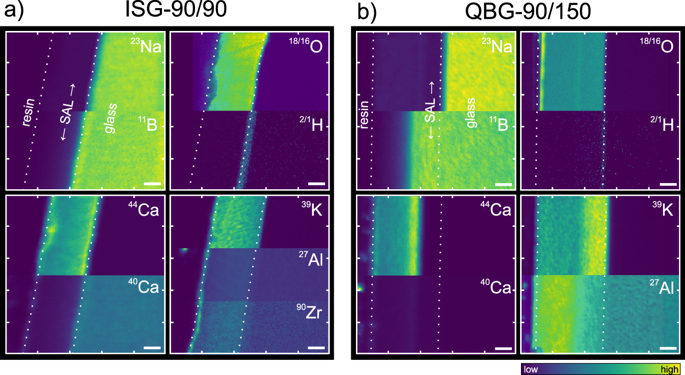npj Materials Degradation ( IF 5.1 ) Pub Date : 2018-09-06 , DOI: 10.1038/s41529-018-0048-z Christoph Lenting , Oliver Plümper , Matt Kilburn , Paul Guagliardo , Martina Klinkenberg , Thorsten Geisler

|
Borosilicate glasses are currently used for the immobilization of highly radioactive waste and are materials of choice for many biomedical and research industries. They are metastable materials that corrode in aqueous solutions, reflected by the formation of silica-rich surface alteration layers (SAL). Until now, there is no consensus in the scientific community about the reaction and transport mechanism(s) and the rate-limiting steps involved in the formation of SALs. Here we report the results of multi-isotope tracer (2H,18O,10B, 30Si, 44Ca) corrosion experiments that were performed with precorroded and pristine glass monoliths prepared from the six-component international simple glass and a quaternary aluminum borosilicate glass. Results of transmission electron microscopy and nanoscale analyses by secondary ion mass spectrometry reveal a nanometer-sharp interface between the SAL and the glass, where decoupling of isotope tracer occurs, while proton diffusion and ion exchange can be observed within the glass. We propose a unifying mechanistic model that accounts for all critical observations so far made on naturally and experimentally corroded glasses. It is based on an interface-coupled glass dissolution-silica precipitation reaction as the main SAL forming process. However, a diffusion-controlled ion exchange front may evolve in the glass ahead of the dissolution front if SAL formation at the reaction interface significantly slows down due to transport limitations.
中文翻译:

建立统一的硅酸盐玻璃腐蚀机理模型
硼硅酸盐玻璃目前用于固定高放射性废物,并且是许多生物医学和研究行业的首选材料。它们是在水溶液中腐蚀的亚稳态材料,反映在富含二氧化硅的表面蚀变层(SAL)的形成上。到目前为止,科学界对形成SAL的反应和转运机制以及限速步骤尚无共识。在这里我们报告了多同位素示踪剂(2 H,18 O,10 B,30 Si,44Ca)腐蚀实验是使用由六组分国际简单玻璃和季硅酸硼铝玻璃制成的预腐蚀和原始玻璃整体进行的。透射电子显微镜和通过二次离子质谱法进行的纳米级分析的结果表明,SAL与玻璃之间存在纳米级锐利的界面,在此处同位素示踪剂发生解偶联,而在玻璃内可以观察到质子扩散和离子交换。我们提出了一个统一的力学模型,该模型可以解释到目前为止对自然腐蚀和实验腐蚀的玻璃所做的所有关键观察。它基于界面耦合的玻璃溶解-二氧化硅沉淀反应作为主要的SAL形成过程。然而,

























 京公网安备 11010802027423号
京公网安备 11010802027423号